 Hydraulics and Environment Department
Hydraulics and Environment Department
Projects - DITOWEC - Development of an Integrated Tool for Numerical Modeling of Oscillating Water Column Wave Energy Converters integrated in vertical Breakwaters
The purpose of the DITOWEC project is the development of an innovative Integrated Tool coupling the numerical models SWAN and COULWAVE, for the wave propagation from offshore to nearshore, and the URANS (Unsteady Reynolds Average Navier-Stokes) numerical models FLUENT and IH2VOF, for wave-structure interaction, hydrodynamics and aerodynamics of the OWC device.
This Integrated Tool will be validated with experimental data from physical model tests performed in one of LNEC’s flumes. Afterwards it will be applied to the real and operating OWC-WEC- of Pico, Azores (Portugal), for real bathymetry and offshore wave climate.
SUMMARY
Breakwaters play a role of dissipating incident wave energy and sheltering harbour basins and entrances against waves, guarantying the safety of ship maneuvers. Besides the breakwater’s classic functions, they have recently been assigned a complementary function: to be the support of wave energy plants for electric production. An example of that is the use of the Oscillation Water Column (OWC) technology. In this technique, as waves enter and exit the plant, the water column inside the OWC plant moves up and down producing an air flow that induces the rotation of a turbine connected to an alternator.
This type of wave energy device can be integrated, during the construction, on a vertical breakwater consisting of caissons of great dimensions. An example of this innovative solution is the wave energy plant of Mutriku, Spain.
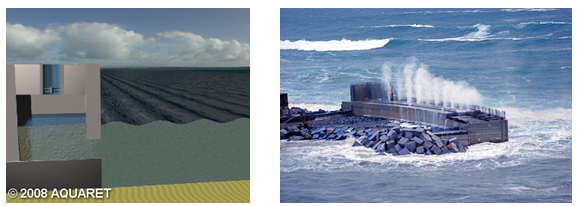
OWC device (left), OWC integrated in a breakwater, Mutriko, Spain (right).
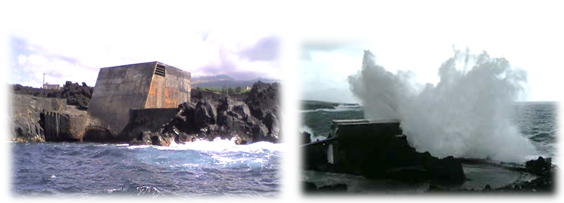
OWC of Pico, Azores.
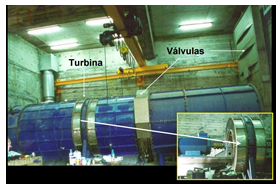
OWC of Pico – air conduct (in blue) where the turbine and generator are installed.
This Integrated Tool will be validated with experimental data from physical model tests performed in one of LNEC’s flumes. Afterwards it will be applied to the real and operating OWC-WEC- of Pico, Azores (Portugal), for real bathymetry and offshore wave climate.
SUMMARY
Breakwaters play a role of dissipating incident wave energy and sheltering harbour basins and entrances against waves, guarantying the safety of ship maneuvers. Besides the breakwater’s classic functions, they have recently been assigned a complementary function: to be the support of wave energy plants for electric production. An example of that is the use of the Oscillation Water Column (OWC) technology. In this technique, as waves enter and exit the plant, the water column inside the OWC plant moves up and down producing an air flow that induces the rotation of a turbine connected to an alternator.
This type of wave energy device can be integrated, during the construction, on a vertical breakwater consisting of caissons of great dimensions. An example of this innovative solution is the wave energy plant of Mutriku, Spain.

OWC device (left), OWC integrated in a breakwater, Mutriko, Spain (right).

OWC of Pico, Azores.

OWC of Pico – air conduct (in blue) where the turbine and generator are installed.
The numerical Integrated Tool is built to support ocean and coastal engineering projects, for implementation of coastal/harbour structures taking in account the real bathymetry and offshore wave climate, wave propagation from offshore to the structure (and inside the OWC device), wave-structure interactions, nonlinear phenomena and interactions between hydrodynamics and aerodynamics of a OWC-WEC.
METHODOLOGY
The Integrated Tool is based on the following approach:
1 - Wave Flume Physical Modeling
The main goals of these tests are the study of the hydrodynamic characteristics of the plant and the validation of the numerical models.
A simplified plant geometry was tested: a chamber with a fully opened airway, allowing free air flow in and out of the chamber.
A geometric scale of around 1:35 was used in order to reduce scale effects.
The tests were performed in one of LNEC’s wave flumes, 50 m long with an operating width and an operating water depth of 80 cm.
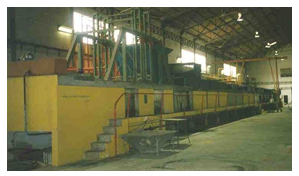
Wave flume at LNEC.

Time series of free surface elevation for the experimental data and numerical results (FLUENT and IH2VOF) for T=0.89 s and H=0.038 m, at gauge G7.
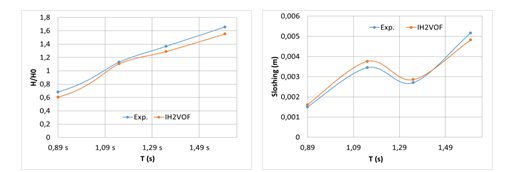
Amplification factor (left) and sloshing parameter (right) for the OWC with open chamber: comparison between physical experiments and IH2VOF.

IH2VOF: free surface elevation (left) and velocity field (right) for case H=0.038 m, T=1.6 s.

FLUENT: velocity field for case H=0.038 m, T=1.0 s.
METHODOLOGY
The Integrated Tool is based on the following approach:
- Physical model tests in one of LNEC´s flumes;
- Detailed analysis of the URANS models for modeling hydrodynamic phenomena (wave-structure interaction, wave propagation) and aerodynamic phenomena (airflow in the pneumatic chamber and turbine duct), mesh convergence for hydrodynamic and aerodynamic flows, numerical scheme accuracy, CPU time, capturing (Volume of Fluid method) and tracking (Arbitrary Lagrangean Eulerian method) approaches for wave propagation and wave breaking, among others;
- Validation of the URANS models and Integrated Tool with data from the physical model tests carried out in one of LNEC’s flume;
- Development of a coupling methodology for the models SWAN, COULWAVE and URANS to obtain the Integrated Tool;
- Optimization of OWC geometry based in an analytical model;
- Application of the Integrated Tool to a real and operating WEC, the 400 kW OWC power plant at the island of Pico, Azores (Portugal), taking in count the real bathymetry and offshore wave climate.
1 - Wave Flume Physical Modeling
The main goals of these tests are the study of the hydrodynamic characteristics of the plant and the validation of the numerical models.
A simplified plant geometry was tested: a chamber with a fully opened airway, allowing free air flow in and out of the chamber.
A geometric scale of around 1:35 was used in order to reduce scale effects.
The tests were performed in one of LNEC’s wave flumes, 50 m long with an operating width and an operating water depth of 80 cm.

Wave flume at LNEC.
The tests have been conducted for an incident regular wave height of 0.038 m (in order to avoid wave breaking) and a wave period ranging from 0.67 s to 2.30 s.

Scheme of the wave flume, water chamber and wave gauge positions (dimensions are in meters).

Physical model near the water chamber for H=0.038 m, T=0.89 s (left) and T=1.6 s (right).

Scheme of the wave flume, water chamber and wave gauge positions (dimensions are in meters).

Physical model near the water chamber for H=0.038 m, T=0.89 s (left) and T=1.6 s (right).
2 - Numerical modeling results
Systematic validation of the RANS models using experimental data, covering:
Systematic validation of the RANS models using experimental data, covering:
- Free-surface elevation, both in the flume and in the chamber;
- Amplification factor, sloshing and phase angle inside the chamber;
- Evaluation of the performance of the integrated tool for studying an OWC wave energy plant.

Time series of free surface elevation for the experimental data and numerical results (FLUENT and IH2VOF) for T=0.89 s and H=0.038 m, at gauge G7.

Amplification factor (left) and sloshing parameter (right) for the OWC with open chamber: comparison between physical experiments and IH2VOF.

IH2VOF: free surface elevation (left) and velocity field (right) for case H=0.038 m, T=1.6 s.

FLUENT: velocity field for case H=0.038 m, T=1.0 s.
PUBLICATIONS
FCT/UNL: José Conde, João Dias e Eric Didier
LNEC: Conceição Juana Fortes, Ana Mendonça, Maria Graça Neves e Maria Teresa Reis
- Dias, J., Mendonça, A., Didier, E., Neves, M.G. and Conde, J.M.P. (2015). "Application of URANS-VOF models in hydrodynamic study of oscillating water column”. SCACR2015 – International Short Course/Conference on Applied Coastal Research. 28th September – 1st October 2015 – Florence, Italy (in press). Doi: 10.13140/RG.2.1.5135.8249.
- Didier, E., Dias, J., Teixeira, P.R.F. and Neves, M.G. (2015). "Numerical modeling of an oscillating water column using Smoothed Particle Hydrodynamics method”. COBEM 2015 – ABCM International Congress of Mechanical Engineering, Rio de Janeiro, Brazil, 6-11 December 2015.
- Mendonça, A., Jalon, M.L., Correia, R., Dias, J., Neves, M.G. and Didier, E. (2015). "Design optimization of an oscillating water column wave energy converter. Analytical and numerical modeling”. SCACR2015 – International Short Course/Conference on Applied Coastal Research. 28th September – 1st October 2015 – Florence, Italy (in press). Doi: DOI: 10.13140/RG.2.1.4709.8405.
- Reis, M.T., Didier, E., Dias, J., Mendonça, A., Conde, J.M.P., Neves, M.G., Fortes, C.J.E.M. and Teixeira, P.R.F. (2015). "Development of an Integrated Tool for Numerical Modelling of OWC-WECs in Vertical Breakwaters". 2nd International Workshop on Hydraulic Structures: Data Validation, IAHR. Coimbra, Portugal, 7-9 May 2015, R.F. Carvalho & S. Pagliara (Eds.), pp. 185-194. ISBN: 978-989-20-5792-7.
FCT/UNL: José Conde, João Dias e Eric Didier
LNEC: Conceição Juana Fortes, Ana Mendonça, Maria Graça Neves e Maria Teresa Reis
Coordinator(s):
Faculdade de Ciências e Tecnologia da Universidade Nova de Lisboa
Funding:
Fundação para a Ciência e a Tecnologia (FCT)
« return




